Yamaha entered the PC audio MIDI scene with their TG100 sound module in 1991. At the time, they were competing directly with Roland's SC-55 Sound Canvas. The TG100 was followed with the TG300 in 1993. The TG-series was followed by the very popular MU-series which introduced Yamaha's superset of General MIDI, called XG.
They also produced several expansion cards for PCs.
TG100 (1991)
 The TG100 (Tone Generator 100) was based around 12-bit PCM samples, whilst its competitor, the Roland SC-55 was using 16-bit samples. This meant many people overlooked the TG100 and went straight for the Roland. The TG100 (Tone Generator 100) was based around 12-bit PCM samples, whilst its competitor, the Roland SC-55 was using 16-bit samples. This meant many people overlooked the TG100 and went straight for the Roland.
Having said that, the TG100 was priced as the economy offering, so those on a budget could still get decent enough MIDI sound for their games. One benefit of the TG-series was its ease of connectivity. Using the supplied 8-pin mini-DIN cable you could connect the TG100 directly to a PC or Mac without the need to purchase a separate MIDI interface (you would use Yamaha's CBX Serial Driver). It also got an audio in socket, allowing you to connect the audio output of your sound card directly to the TG100, where you could then have both the GM sound and the sound card's output (such as digitised speech or sound effects) all go through the TG100 and out to speakers directly from there.
It used AWM (Advanced Wave Memory) synthesis, and comprised 140 samples onboard its 2 MB ROM chip. It was able to output 28-voice polyphony and 16 parts multitimbre. It also featured six different kinds of reverb and two kinds of delay.
Drivers
|
TG300 (1993)
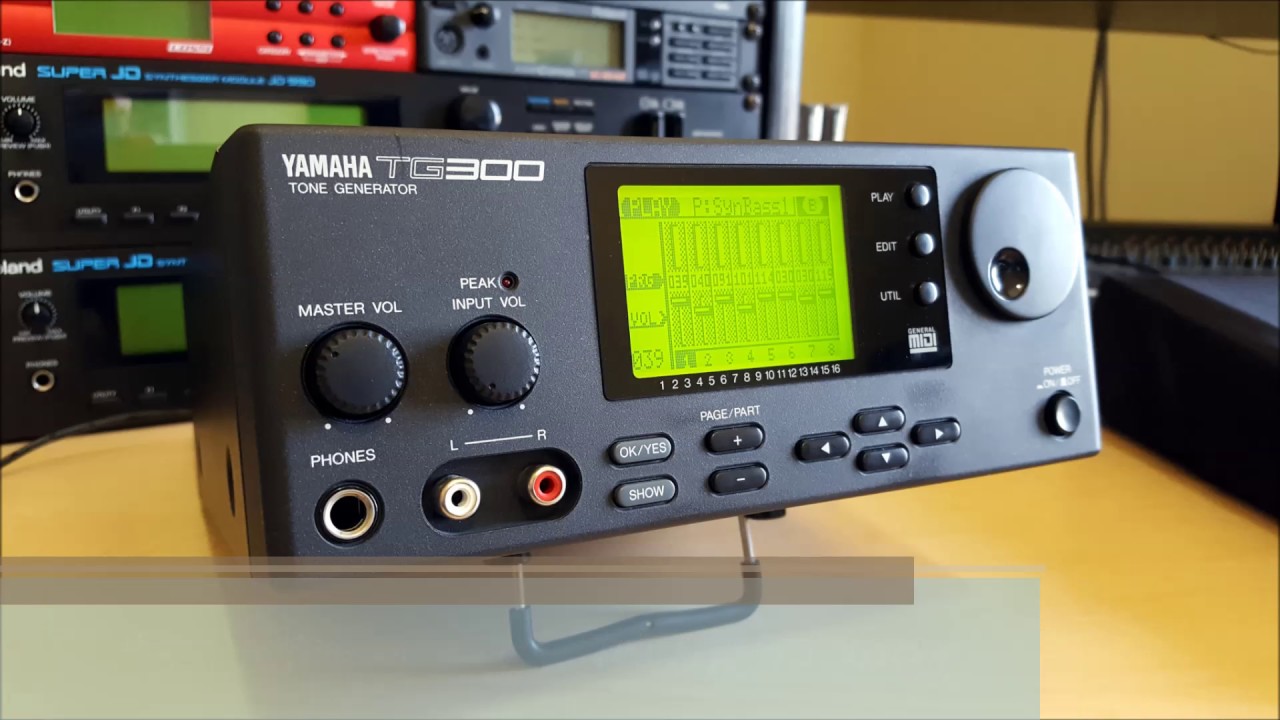 The TG300 provided up to 64 parts multitimbre and featured 48 preset effects of which 16 are editable. It came with 294 AWM2 (Advanced Wave Memory) synthesized samples - double that of the TG100 - but really stepped up its game in the area of filters. It got a digital resonant low pass filter, dedicated 5-stage amplitude, pitch and filter envelopes, The TG300 provided up to 64 parts multitimbre and featured 48 preset effects of which 16 are editable. It came with 294 AWM2 (Advanced Wave Memory) synthesized samples - double that of the TG100 - but really stepped up its game in the area of filters. It got a digital resonant low pass filter, dedicated 5-stage amplitude, pitch and filter envelopes,
|
MU5 (1994)
 The TG-series was superceded by the MU-series in 1994 with the introduction of the MU5. Based on the TG100, it is a 28-voice, 16-voice multitimbral, sample based (GM compatible) synthesizer, featuring dedicated (AR) amp envelope, an LFO, computer and MIDI interfaces, and 256 presets (64 editable). The TG-series was superceded by the MU-series in 1994 with the introduction of the MU5. Based on the TG100, it is a 28-voice, 16-voice multitimbral, sample based (GM compatible) synthesizer, featuring dedicated (AR) amp envelope, an LFO, computer and MIDI interfaces, and 256 presets (64 editable).
|
MU80 (1994)
Price when new: £699 inc. VAT. ($899 USD)
 Possibly the best-known of the MU-series for PC gamers, the MU80 introduced Yamaha's new extension to the General MIDI standard, Yamaha XG. It offered 64-voice polyphony and 32-part multitimbrality. Its built-in ROM contained 729 patches (samples), and 21 drum kits. As with the earlier TG-series, the MU80 allowed for audio input from the PC or Mac, so you could feed it through the MU80's internal effects. Possibly the best-known of the MU-series for PC gamers, the MU80 introduced Yamaha's new extension to the General MIDI standard, Yamaha XG. It offered 64-voice polyphony and 32-part multitimbrality. Its built-in ROM contained 729 patches (samples), and 21 drum kits. As with the earlier TG-series, the MU80 allowed for audio input from the PC or Mac, so you could feed it through the MU80's internal effects.
The MU80's direct competitor was the Roland SC-88. It used the same 8-pin mini-DIN as the TG-series for direct connection to your PC or Macintosh. For the PC it uses Yamaha's CBXT3 serial driver. There is a 'mode' switch on the back where you can tell the MU80 to operate in one of four modes: XG, TG300, C/M, and Performance. Both TG300 and C/M (Computer Music) modes are provided for backwards compatibility with the Yamaha TG300 and Roland CM devices. XG is the Yamaha GM extension, equivalent to Roland's GS.
The MU80 comes with built-in distortion effects as well as a 'wah'. It also gets an A/D input for external instruments to be connected.
How does it compare to the Roland SC-88? This is very subjective, but the general concensus is that the Yamaha is more metallic/rocky sounding where the Roland is softer and warmer. Both sound incredible, so it often depends on the game you are playing as to which you prefer the sound of.
You can compare the audio output of the MU80 side-by-side with numerous other sound cards and external MIDI synthesizers in my Sound Blaster 16 CT2770 Retro Review. |
MU50 (1995)
 A cut-down version of the MU80, the MU50 had only 16-part multitimbrality, A cut-down version of the MU80, the MU50 had only 16-part multitimbrality,
It has the external input of the earlier MU80, but you cannot apply effects to it. |
MU10 (1996)
 The MU10 was the same as the QS300 minus the front panel editing features, sequencer, and half the elements. It was a GM-compatible sample based synthesizer able to output up to 32-voice multitimbre, featuring up to 2 elements, 65 effects (reverb, chorus, variation), MIDI, 21 drum kits, and 676 presets. The MU10 was the same as the QS300 minus the front panel editing features, sequencer, and half the elements. It was a GM-compatible sample based synthesizer able to output up to 32-voice multitimbre, featuring up to 2 elements, 65 effects (reverb, chorus, variation), MIDI, 21 drum kits, and 676 presets.
|
 MU90 (1996) MU90 (1996)
An enhanced version of the MU80, the MU90 got a further 50 instruments and 9 more drum sets over the MU80. It also added 2 processors to allow greater flexibility when applying effects to individual channels.
Two variants of the MU90 were also released - a budget MU90B which is akin to Roland's ST range (e.g. SC-55 ST) in that it lacks an LCD display, and the MU90R which is a rack-mounted 1U version but is otherwise identical to the standard MU90. |
 MU100 (1997) MU100 (1997)
The MU100 continued what the MU90 did, adding a further 488 instruments and 16 more drum sets over the MU90. It also got four processors for independent effects.
Starting with the MU100 the set of samples Yamaha installed in these differed from the earlier XG synths (The MU80, MU50, MU90 and MU10). The newer sample set is not particularly 'better' than the earlier ones - many of the acoustic instruments have been improved.
A budget MU100B was also released, which is akin to Roland's cheaper ST range (e.g. SC-55 ST) in that it lacks an LCD display. |
 DB50XG (1997) DB50XG (1997)
The DB50XG was Yamaha's one and only wavetable module. Suitable for use with any sound card that had a Wave Blaster header, the DB50XG fully supported the General MIDI standard as well as Yamaha's own XG extension to it.
It is based on the MU50 external tone generator, and so it also supports a TG300B mode, though unlike the MU50 it does not support C/M or Performance modes.
It ran an HD6413002FP16 CPU alongside an AK4510 DAC.
The sample set comprised 676 instruments, 21 drumkits, while in XG mode is had 480 melody voices and 11 drumkits. On the effects side, it had 11 Reverb types, 11 Chorus types and 42 variations. |
 SW60XG SW60XG
Introduced: 1997
FCC ID: A6RSW60
The SW60XG was Yamaha's equivalent of the Roland SCC-1 - they took their DB50XG wavetable daughterboard and put it onto a 16-bit ISA card. It was fully General MIDI-compatible as well as supporting Yamaha's own XG extension to it, and it supported up to 32 voices, and came with a 4 MB sample ROM.
Note that SW60XG does not provide any FM synthesis support - this is a MIDI-only (wavetable) card. Having said that, it does also have a microphone input, line-in and CD inputs that with the use of the provided software can perform realtime editing of analog sound.
In total the patchset comprised 676 instruments, 21 drumkits. In XG mode, it had 480 melody voices and 11 drumkits. On the effects side, it had 11 Reverb types, 11 Chorus types and 42 variations.
The unit can also be put into TG300 mode to use [a variation of?] the patchset from that model. In this mode are 579 instruments and 10 drumkits.
Just like the DB50XG, it ran an HD6413002FP16 CPU alongside an AK4510 DAC.
Drivers
User Manual
More Images
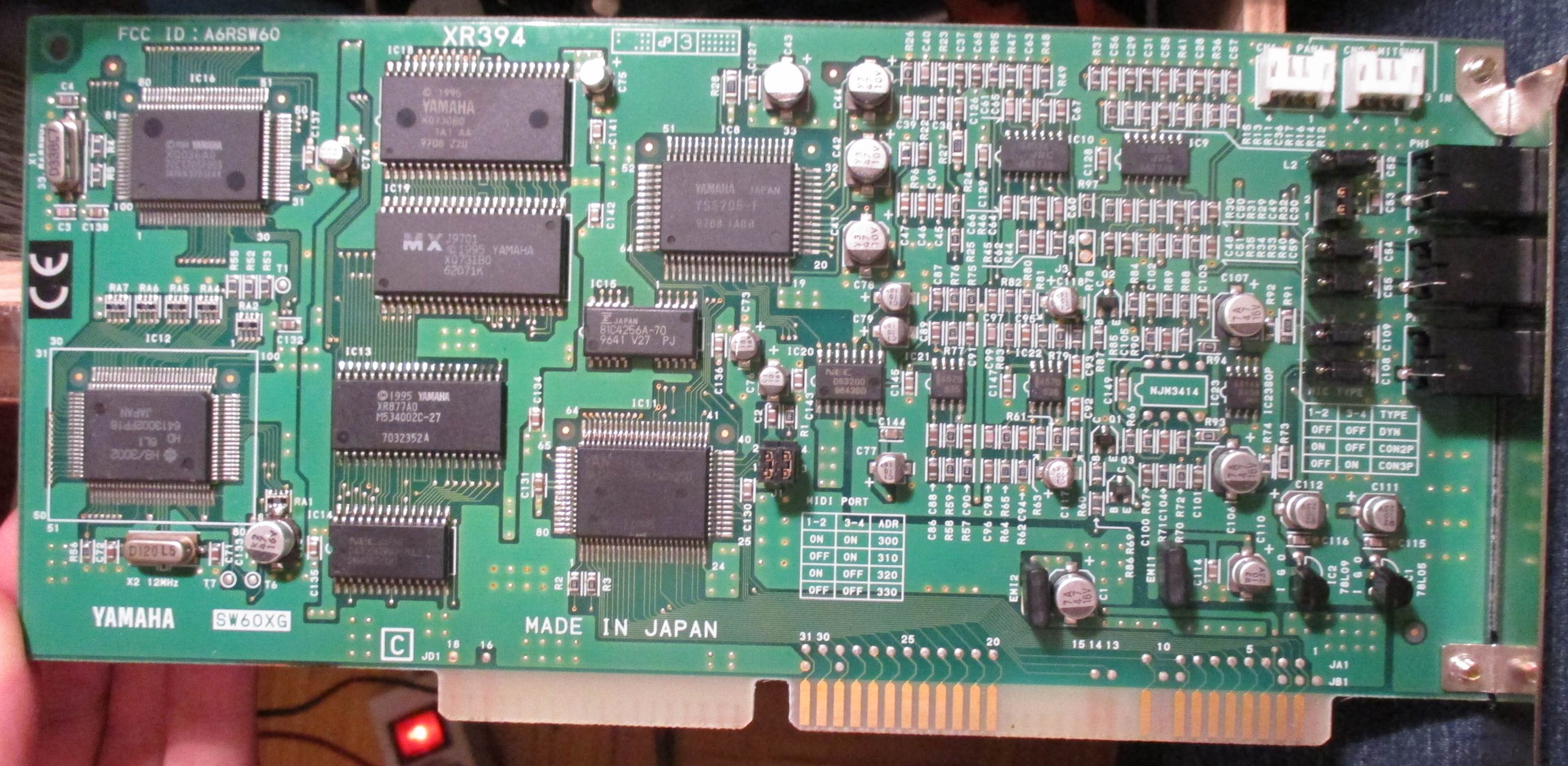 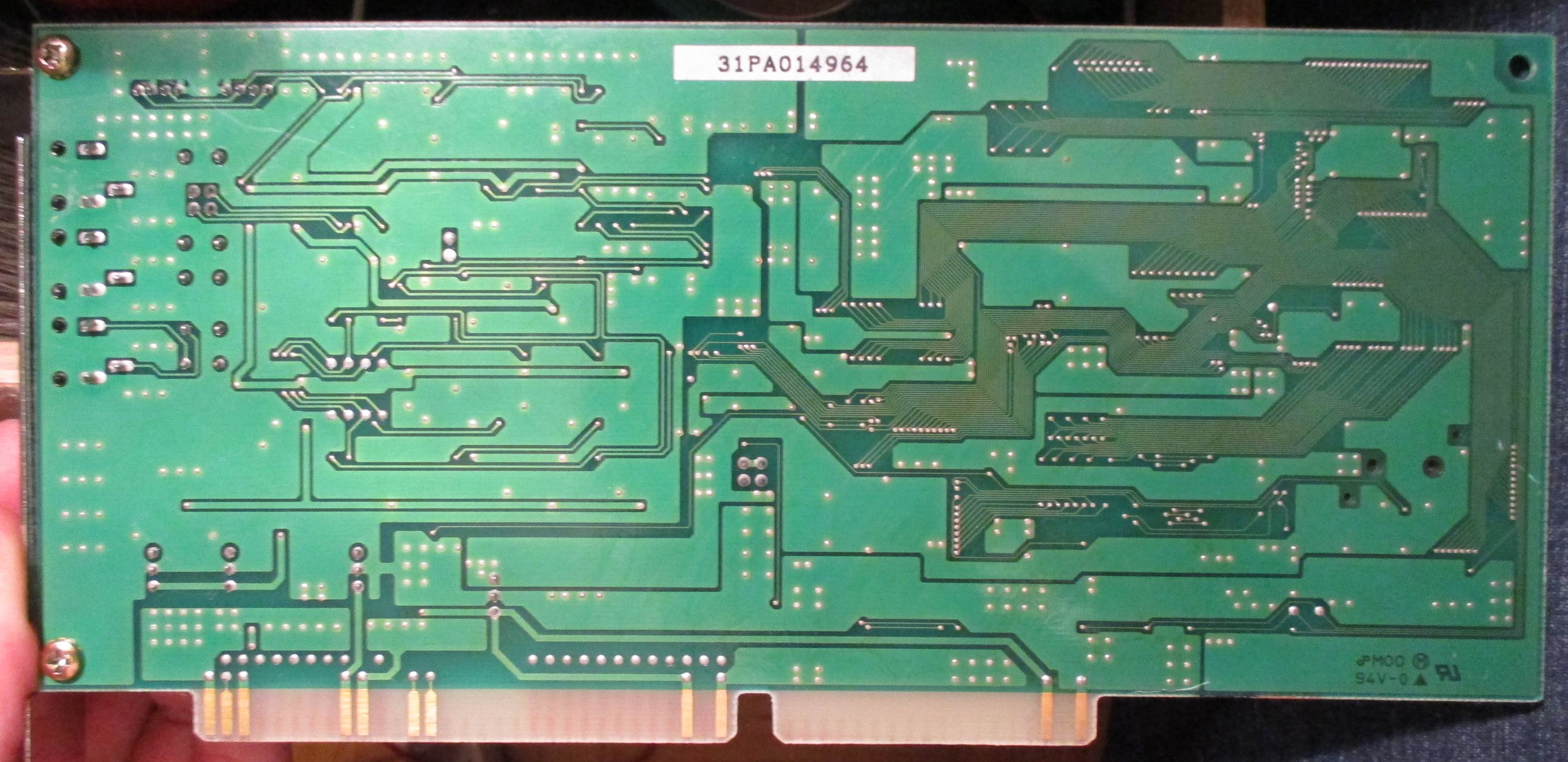
   
|
 Audician 32 Plus (A151-510) Audician 32 Plus (A151-510)
Introduced: 1997
FM synthesizer: Yamaha YM719E-S (OPL3).
Sound Blaster, Sound Blaster Pro 2.0 and Windows Sound System compatible.
MPU-401 UART via game port.
Wavetable header.
IDE/ATAPI interface.
FCC ID: LWHA151510
Like the A151-A00, the A151-510 also uses the YMF719E-S which is the third generation of OPL3-SAx chip.
As with others in the range, it has solder pads for the AdMos QDP QS1000 and associated 1 MB ROM chip for samples.
You can compare this card's audio output side-by-side to numerous other cards in my Sound Blaster CT2770 Retro Review!
More Images

|
 Audician 32 Plus (A151-830) Audician 32 Plus (A151-830)
Introduced: 1996
FM synthesizer: Yamaha YM701-S (OPL3).
Sound Blaster, Sound Blaster Pro 2.0 and Windows Sound System compatible.
MPU-401 UART via game port.
Wavetable header.
IDE/ATAPI interface.
FCC ID: LWHA151830
I was unaware this '830' model even existed until recently (2021). Due to the fact it uses the YM701-S which is also called OPL3-SA, i.e. first generation, it most likely predates the more common A151-A00which uses the YMF719E-S which is third generation.
Interestingly though, the card has solder pads for an OPL4 chip, Yamaha YMF-704-S. This is a full wavetable and 1 MB ROM sample set in a single chip.
The Yamaha Audician 32 Plus was sold to numerous OEMs for them to brand and sell, including:
More Images
 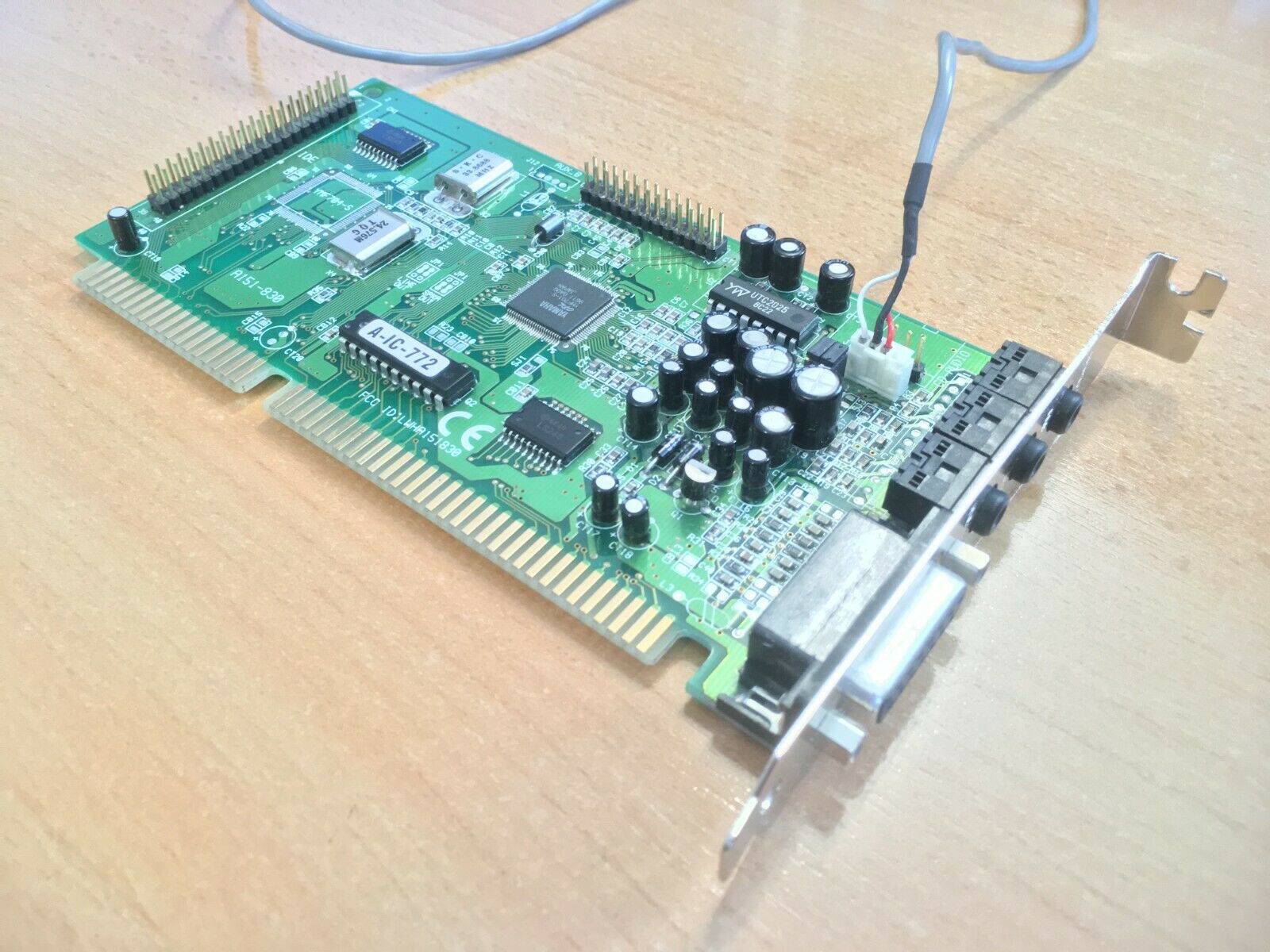   
|
 Audician 32 Plus (A151-910) Audician 32 Plus (A151-910)
Introduced: 1996
FM synthesizer: Yamaha YM718-S (OPL3)
MPU-401 UART via game port
Wavetable header
IDE/ATAPI interface
FCC ID: LWHA151910
The A151-910 is Sound Blaster, Sound Blaster Pro 2.0 and Windows Sound System compatible. They are known to be rather loud (audible volume-wise), even after reducing the volume in the OPL3-SAx config utility. Clipping on the wavetable output is evident even on the lowest volume setting.
Electrical noise - the card has much better frequency response than Creative's Sound Blaster Pro 2.0 and the Terratec 16/96.
The card has solder pads for an AdMOS QDSP QS1000 wavetable chip and a sample ROM chip above it. Some cards (like the one below) have a "3D" switch at the top of the faceplate, presumably to enable or disable the 3D positional audio.
More Images

|
.jpg) Audician 32 Plus (A151-A00) Audician 32 Plus (A151-A00)
Introduced: 1997
FM synthesizer: Yamaha YM718E-S (OPL3) or YMF719E-S.
Sound Blaster, Sound Blaster Pro 2.0 and Windows Sound System compatible.
MPU-401 UART via game port.
Wavetable header.
FCC ID: LWHA151A00, NCXY510
This same card was manufactured by different companies including Addonics, Labway, Genius, UMax, Bannsan and Aopen, although the Yamaha reference design got the CD-ROM header and few extras over this. It's apparently quite a loud (volume, not signal noise!) card even after reducing the volume via "mixerset.exe". Wavetable output can exhibit clipping even after reducing the volume to the lowest settings. Compared to SB Pro 2 or Terratec 16/96, the output of this card is much clearer.
Some versions of the A151-A00 came with the AdMOS QDSP QS1000 wavetable chip and QS1001 sample ROM chip. See more images below.
All you need is SETUPSA.EXE. This initializes any Yamaha SAx chip (701, 704, 715, 718, 719) in DOS. One thing you may notice is that when running in Sound Blaster 2.0 mode, the left and right audio channels appear to be reversed. Some games have an option to flip the audio.
Another option for configuring this card is to use the driver software from the MediaTrix 3D-XG, as this is excellent, and works with any YMF-71x-based sound card.
In some cases, the OPL works fine in every game, but the PCM audio is buggy (gets cut off, crashes the game, or most often, won't play at all) in most games, with the exceptions being Descent and Quake from the games I've tried, which work fine.
If using "Line-in", it will only work if setupsa /s is run first.
Terminal Velocity reacts the worst to my card, hanging the entire system after playing a test sound once that is supposed to be played twice. If you're using DMA channel 0 then try changing it to DMA channel 1 or 3 - some newer boards such as this do not always play along with DMA0 on the YMF71x chips. Locking out DMA 0 by assigning it to "Legacy ISA" in the BIOS makes things work a bit better, though Doom will not play sound if General MIDI is enabled.
On the Yamaha Audician driver disk is the drivers for DOS, Windows 3.1, 95, and 98. When you install these for Windows, it automatically installs the DOS drivers as well. On the contained CD there is also a separate DOS installer under the DOS folder, where you can run install.exe which will configure your config.sys and autoexec.bat files for you.
All in all, this is a fantastic card for DOS gaming - it produces very clean sound, has no hanging note bugs, works great in DOS and Windows (where it has a Soft Midi synth mode!) and works with most DOS games. Compared to a lot of cards from Creative which tend to be noisy (electrical inteference-wise), this card is very quiet (again, electrical noise-wise).
More Images
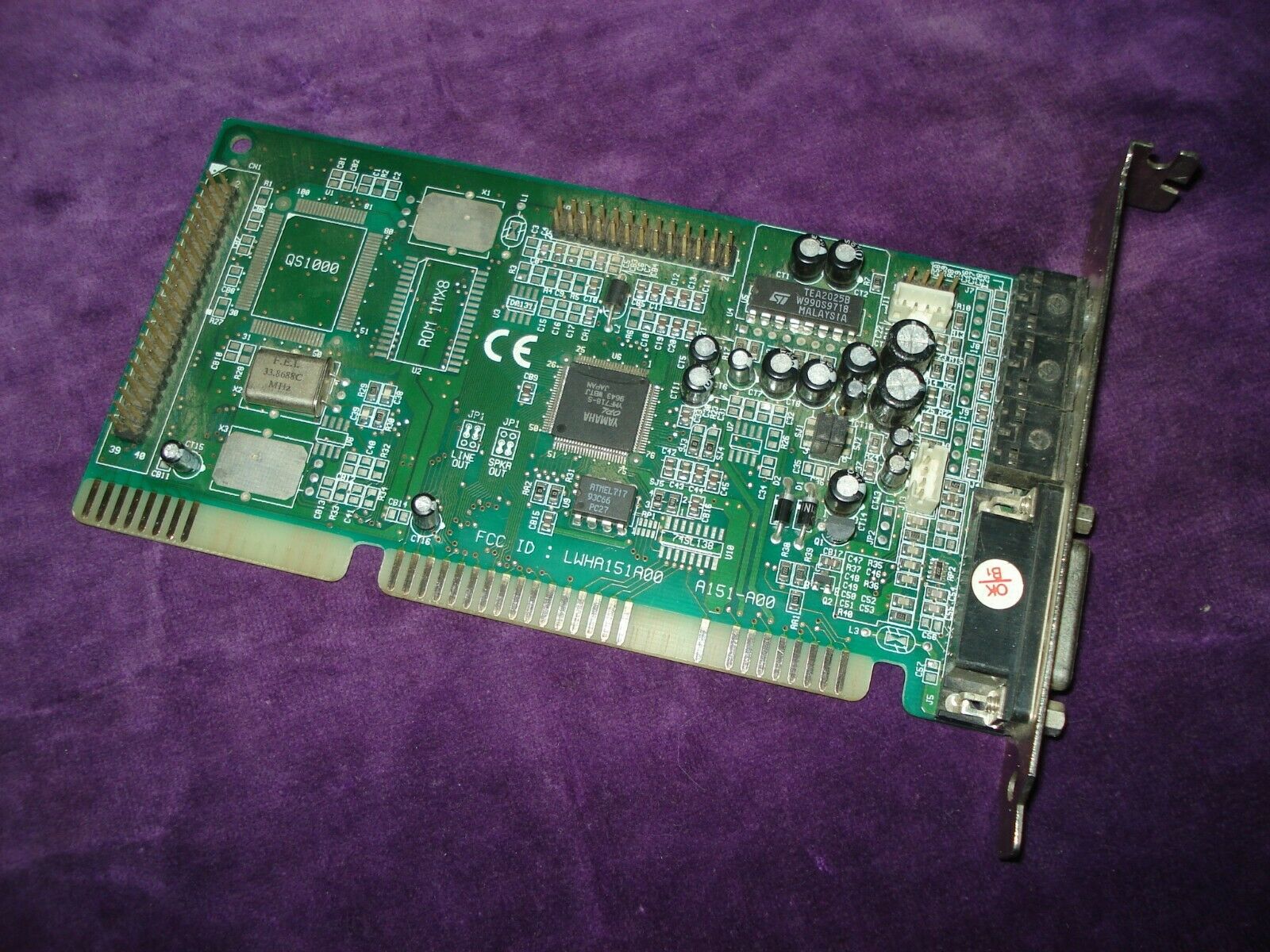         
Thanks to Eirik Øverby for providing images of his card that closely resembles a Yamaha Audician 32 Plus, but is the Philips PCA750AF:
   
These 3
images of a Genius-branded Audician 32 Plus A00 are courtesy of Dusko Marincic:
  
These 2 images of a Labway A151-A00 are courtesy of targeted:
.jpg) .jpg)
Drivers
Audician 32 Drivers
  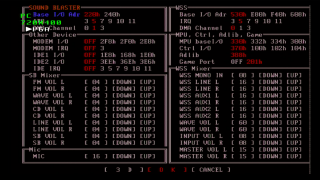    
|
 Audio Wave Audio Wave
FM synthesizer: Yamaha YM718-S (OPL3).
Wavetable header.
More Images
  
|
 Sound Edge Sound Edge
Introduced: March 1996
FM synthesizer: Yamaha YMF278B (OPL4).
Chipset: OPTi 82C928 (MAD16).
Audio codec: Analog Devices AD1848KP.
The Sound Edge was Yamaha's first multimedia PC sound card. Up until this point, Yamaha was at the forefront of PC audio chipsets, but had never released their own card.
Sony, Mitsumi and Panasonic CD-ROM interfaces.
|
Waveforce XG
Introduced: 1998
Chipset: Yamaha YMF74x
FM synthesizer: (embedded)
Audio codec: (embedded)
Interface: PCI
Wavetable Memory: 2 MB
Sample Rate: 5Hz - 49 kHz, full duplex
One of [if not the] first PCI sound cards from Yamaha.
"Yamaha are renowned the world over for their high quality range of hi-fi equipment speakers and keyboards. It's no surprise then, that the XG sound card is also of an exceptional standard.
One of the nicest features about this card is that it isn't trying to be too many things. It doesn't have gimmicky 3D sound support that muffles sound and is virtually useless. Instead, it offers exceptional sound quality with a crispness and clarity that is something to behold.
Whether playing a CD, MP3 or wave file, this card outputs hiss and distortion free sound. Proof of this card's excellent sound quality can actually hit
you rather unexpectedly. When listening to a familiar music CD, you're suddenly able to hear sounds you've never heard before.
MIDI support is also very good. It doesn't feature downloadable sound font tables such as the AWE32/64, but its 676 different instruments along with 21 separate drum kits are all of an above average standard.
Although it doesn't offer 4 speaker surround such as the Diamond Monster Sound, the absolutely exceptional quality of the sound that's output from this silicon wonder makes it a perfect choice for a 2 speaker gaming solution." PC PowerPlay, July 1998
|
 Yamaha
Yamaha
























.jpg)
















.jpg)












